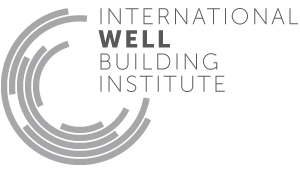Appendix A: Glossary
| Equivalent Melanopic Lux (EML) |
A measure of light used to quantify how much a light source will stimulate melanopsin's light response. |
| Footcandle (fc) |
Unit of illuminance, equivalent to one lumen per square foot. |
| Frequency (f) |
The number of times an event repeats itself per a specified unit of time. Hertz (Hz) is a common unit for frequency and equals cycles per second i.e. 1 Hz = 1 cycle/second. Most commonly used with waves (sound and light) and is the number of times the wave repeats itself at its particular wavelength. |
| Illuminance (Lux) |
Amount of light passing through a given area in space. Measured in lux or foot-candles. |
| Impact Insulation Class (IIC) |
Extent to which a physical structure blocks out sound, typically used in describing flooring, a higher IIC reduces footfall noise, and other impact sounds. |
| Light Reflectance Value (LRV) |
Rating from 0 (black) to 100 (white) describing the amount of visible and usable light that reflects from (or absorbs into) a painted surface. |
| LRV |
Light Reflectance Value; measures the amount of visible and usable light that reflects from (or absorbs into) a painted surface. |
| Lumens |
Measure of luminous flux, derived from the SI base unit candela, and therefore weighted to the eye's sensitivity to light; 1 W of light at 555 nm equates to 683 lumens. |
| Luminance (cd/m²) |
Measurement of how bright a surface or light source will appear to the eye. Measured in candela/m² or foot-lamberts. |
| Luminous Flux |
Total luminous output of a light source, measured in lumens. Weighted to the eye's visual sensitivity. |
| Luminous Intensity |
Radiant power weighted to human vision, describing light emitted by a source in a particular direction. Measured by the candela. |
| Lux |
Unit of illuminance, one lux being equivalent to one lumen per square meter. |
| Maximum Contaminant Level Goal (MCLG) |
Concentration of a substance in drinking water believed to result in no adverse effects. Derived from on Population Adjusted Dose and estimated daily water consumption, fraction of exposure from water and body weight. |
| Maximum Contaminant Levels (MCL) |
Enforceable water quality limits for a substance, based on the Maximum Contaminant Level Goal, but taking into account technology and cost limitations of treatment. |
| Mean Radiant Temperature (MRT) |
The uniform surface temperature of an imaginary black enclosure in which an occupant would gain or lose the same amount of radiant heat as in the actual non-uniform space; MRT is a primary driver of human thermal comfort, roughly equal in influence to air temperature. |
| Metabolic Rate (MET) |
Rate that chemical energy in the body is converted to heat and mechanical energy. |
| Micro-Ra |
Roughness rating of a physical surface, averaged in micro-meters & micro-inches. |
| Milliwatt (mW) |
Unit of measurement for electromagnetic radiation, equal to 1/1000 watt. Not weighted to biological responses such as vision. |
| Minimum Efficiency Reporting Value (MERV) |
Value assigned to an air filter to describe the amount of different types of particles removed when operating at the least effective point in its life. |
| Nephelometric Turbidity Units (NTU) |
Measure the turbidity of water. |
| Noise Criteria (NC) |
Define the sound pressure limits of the octave band spectra ranging from 63-8000 Hz. The noise criteria equals the lowest curve which is not exceeded in the spectrum. |
| Noise Criterion (NC) |
Rating indoor noise established in the U.S. |
| Noise Isolation Class (NIC) |
Field test for determining the sound transmitting abilities of a wall. Higher NIC values indicate better sound insulation i.e. more effective sound cancellation between spaces. NIC specifications are defined in ASTM Standard E366. |
| Noise Reduction Coefficient (NRC) |
Average value that determines the absorptive properties of materials. |
| Parts per Billion (PPB) |
Measurement of the mass of a chemical or contaminate per unit volume of water. |
| Parts Per Million (PPM) |
A unit of measurement to express very dilute concentrations of substances. |
| PicoCurie per Liter (pCi/L) |
A non-SI unit of radioactivity. |
| Relative Humidity |
The ratio of the amount of water vapor in the air at a specific temperature to the maximum amount that the air can hold at that temperature, expressed as a percentage. |
| Relative Humidity (rH) |
Ratio of partial pressure of water vapor in the air to the saturation pressure of water vapor at the same temperature and pressure. |
| Reverberation Time (RT) |
Time it takes for sound to decay. The most commonly used reverberation time is RT60, the time it takes for the sound level to decrease 60 decibels. Additional reverberation time measurements are RT20 and RT30, for decreases of 20 and 30 decibels, respectively. |
| Sound Pressure Level (SPL) |
Sound pressure level (SPL), also known as acoustic pressure, is the pressure variation associated with sound waves. Usually measured in decibels, the acoustic pressure is a ratio between the measured value and a reference value; a common reference is threshold of hearing or the minimum sound level that the average person can hear. |
| Sound Transmission Class (STC) |
A laboratory method for determining the sound transmission through a wall. Higher STC values indicate more effective noise isolation than lower ones. STC specifications are found in ASTM Standards E90-09 and E1425. |
| Spatial Daylight Autonomy (sDA) |
Percentage of floor space where a minimum light level (for example 300 lux) can be met completely for some proportion (for example 50%) of regular operating hours by natural light. |
| Algae |
A simple nonflowering plant of a large group that includes the seaweeds and many single-celled forms. |
